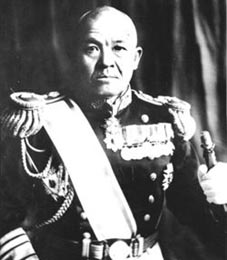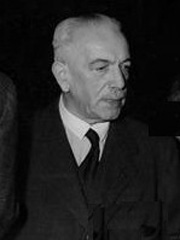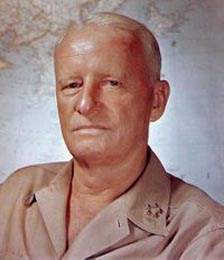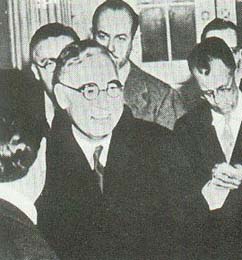Commander of the Japanese 1st Air Fleet and strong proponent of the integration of air and sea power, was in direct control of the air attacks against Pearl Harbor, the Dutch East Indies, northwest Australia, Ceylon and India during the huge Japanese offensive between December 1941 and May 1942; following the loss of 4 aircraft carriers at the pivotal Battle of Midway, however, appears to have suffered from a serious loss of confidence; was transferred from command of the Japanese carrier forec to lead a small naval flotilla in the Marianas; later organized the defenses of Saipan and committed suicide there in July 1944 during the latter stages of the American conquest of the island.

an aristocratic career diplomat and German Foreign Minister from 1932, was one of a small number of German cabinet ministers to retain office after Hitler's takeover of power in 1933, largely in order to boos the Nazi Party's respectability vis-à-vis foreign governments; was removed from his post in February 1938, however, as a result of his public opposition to Hitler's 'Hossbach Conference' revelations in November 1937; the Hossbach Memorandum stunned military and civilian delegates to the conference by outlining Hitler's version of Lebensraum, living space, for Germany and Germanic peoples, and its fulfilment by way of war on both eastern and western fronts, including Britain and France among the possible belligerents; was succeeded by the more compliant Ribbentrop, and subsequently held only titular posts, most notably as Protector of Bohemia and Moravia (Czechoslovakia) from 1939 to 1941; was included amont the major war criminals tried at Nuremberg and was sentenced to 15 years imprisonment, but was released in 1954 on health grounds.

Popular and astute American admiral who succeeded Adm Husband Kimmel as the C-in-C of the US Pacific Fleet after the devastating Japanese attack on Pearl Harbor and was directly responsible for the rebuilding and development of the US Navy; gathering a core of highly capable naval commander to cover the huge expanse of ocean for which he was responsible, firmly advocated the use of modern techniques of naval warfare and made the earliest possible use of the air strike power of his carriers in operations against Japanese bases on Wake Island, the Gilbert and Marshall Islands and on New Guinea; his first strategic victory, at the Battle of the Coral Sea in May 1942, was followed a month later by the crucial victory at Midway; exploiting the unique advantage offered him by the intelligence gained through Magic intercepts, which provided detailed information on the Japanese offensive plan, was able to deploy his forces to fight off a superior force and decisively halt the Japanese strategic initiative in the Central Pacific, ending the Japanese threat to Hawaii and the Panama Canal. By the end of the year, had consolidated this achievement with another crucial success at Guadalcanal; target for the first American offensive and large-scale amphibious assault of the war, the land and sea battles around Guadalcanal in the second half of 1942 stretched both commanders and troops to the limit of their experience and endurance; the final outcome put the United States in control of sea and air in the Southern Solomons. During 1943, following the division of the Pacific into two commands under Nimitz (Central Pacific) and Gen MacArthur (Southwest Pacific) and the reinforcement of the US Pacific Fleet with new ships and aircraft, strongly favored the development of a Central Pacific island campaign, based on amphibious assaults, as the most effective way to defeat Japan; although this approach was in direct contention with Gen MacArthur's preferred line of attack, via the Philippines, it was agreed by the Joint Chiefs of Staff and initiated with assaults on the Gilbert Islands (Makin and Tarawa), followed by strikes at Kwajalein, Eniwetok and Truk in early 1944; employing his submarine force to blockade Japanese merchant shipping while his fast carrier task forces opened the way for successive assaults on Saipan, Guam and Palau, his forces effectively drove the Japanese forces back to the limits of their defensive perimeter; working in concert with Gen MacArthur, whose fanatical insistence had finally persuaded the Joint Chiefs to approve his offensive via the Philippines in late 1944, presided over the major victories at Leyte gulf, Okinawa and Iwo Jima, which took the US Fleet within striking range of the Japanese home islands; was promoted to Fleet Admiral on December 19, 1944. Following the Japanese surrender, which was formally accepted on board his flagship, the USS Missouri, on September 2, 1945, succeeded Admiral Ernest King as Chief of Naval Operations; his contribution to the American victory in the Pacific, as a skilled strategist and a decisive commander, was acknowledged in many decorations and reflected in the immense personal popularity that he enjoyed within the American armed forces.

admiral, diplomat and Japanese ambassador to the United States at the time of Pearl Harbor, abrogated Japan's treaty of commerce with the US as foreign minister in late 1939; with Saburo Kurusu, negotiated with Cordell Hull, the American secretary of State, from April through November 1941; tried earnestly to avert war without compromising Japan's position on the Asian mainland; both he and Hull wanted to turn Japan away from the Axis and toward an accommodation with the US; his ambiguity and vacillation, which greatly imperiled the negotiations, were caused by his imperfect English, his diplomatic inexperience and the uncertain political climate in Tokyo, and also by his hope of forestalling war by letting the talks drag on as long as possible; this tactic failed when the Japanese government took the Hull note of November 26 as an ultimatum; through confusion and communications delays that were symbolic of the entire negotiations, met with Hull to announce the impending attack on Pearl Harbor more than an hour after it had already begun.
